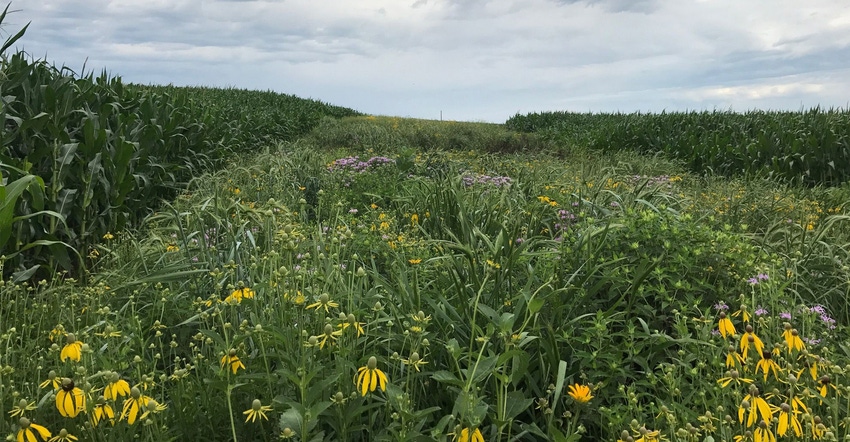August 4, 2017

By some counts, there is less than 1% of the native tallgrass prairie still intact in the U.S. Most of what remains in the Midwest can be found in places like the Flint Hills region of Kansas, or in larger restored tracts like Midewin National Tallgrass Prairie Preserve in Illinois.
Throughout the last 30 years of the Farm Service Agency’s Conservation Reserve Program and the Natural Resources Conservation Service's Environmental Quality Incentives Program, landowners have voluntarily planted acres of tallgrass prairie on their Midwest farms and ranches.
Recently, some have taken the concept a step further — strategically placing prairie strips within cash crop fields to mitigate erosion and runoff, and in some cases, filling other roles.
So, how are prairie strips different from standard contour buffers and filter strips?
According to Lisa Schulte-Moore, researcher with the program STRIPS and natural resources professor at Iowa State University, prairie strips must be wide enough to handle the area of the contributing watershed. Edge-of-field prairie strips, similar to filter strips, are required to be used in tandem with contour prairie strips to ensure all of the water running off an area is treated before it enters a surface water source. In addition, buffer and filter strips are typically planted with a cool-season perennial monoculture — usually brome or tall fescue — while prairie strips are planted to a suite of diverse natives.
Researchers from STRIPS, which stands for Science-based Trials of Row crops Integrated with Prairie Strips, first started working with growers in 2012 and are now working with 30 different farmers and landowners in Iowa and Missouri.
"For all the farmers we're working with, reducing erosion is the biggest factor. They want to keep soil on their land," says Schulte-Moore. "Also, because we slow that water down, we allow it to infiltrate, so it can be available later in the year. Much of the water is transpired as well, so you have much less water moving across the hill slope."
Most farmers in the STRIPS program are using CRP to implement prairie strips, while some have used other cost-share programs available, and others are simply doing it on their own.
Financial incentives for these kinds of prairie strips aren't available in Nebraska like they are in Iowa, but Ritch Nelson, NRCS state wildlife biologist, notes there are some viable alternatives.
For example, through CRP or EQIP, landowners can get creative and implement contour buffer strips, which are, for all intents and purposes, a prairie strip. Or landowners could implement contour buffers and receive compensation for forgone income through EQIP, which generally provides more flexibility in the width of contour buffer strips. Unlike the STRIPS program, these are typically limited to 15 to 30 feet in width and aren't always accompanied by a filter strip.
"Most of our producers as a general rule are dynamic in that if they implement a conservation structure, they'll do it for multiple reasons — to meet conservation objectives but also as an additional income," Nelson says.
However, there may be some additional roles that buffer and filter strips can fill.
Nebraska Extension educator Keith Glewen has experimented with a few different types of prairie strips at the Eastern Nebraska Research and Extension Center (ENREC), including native pollinator mixes, Roundup Ready alfalfa strips and switchgrass strips.
Native prairie strips, in particular, require an added level of management — especially when it comes to controlling weeds like marestail. Schulte-Moore notes weed issues can be overcome through frequent mowing in the first year and potentially the second year. After this, spot treatments will be needed.
While not prairie strips in the conventional sense, switchgrass strips or Roundup Ready alfalfa strips provide a chemical alternative to control weeds that encroach on the strip, while still serving the benefit of mitigating erosion.
While alfalfa provides an additional hay source for landowners that can find a way to properly cure it in the middle of a cornfield, switchgrass or prairie strips could also serve as an additional source of cattle feed. Growers could harvest and grind forage from switchgrass or prairie strips later in the season and mix them with distillers grains.
In addition to their erosion-control benefits, prairie strips can also mitigate nutrient runoff. From 2007 to 2012, STRIPS researchers found fields with only 10% prairie reduced sediment loss by 95%, total phosphorus loss by 90% and total nitrogen loss by nearly 85%, compared to losses from fields consisting completely of no-till annual crops.
Glewen notes there are also long-term benefits to soil health — building organic matter and infiltration over time — although all benefits take an added level of management. "It's not short term; it's long term. That's the hard thing for agriculture to get its arm around is the value of soil conservation," says Glewen. "The vehicles we buy now you don't have to check the tire pressure. You push a button and it tells you. The land isn't like that. We don't have those kinds of buttons."
Learn more about the STRIPS program at prairiestrips.org.
You May Also Like




